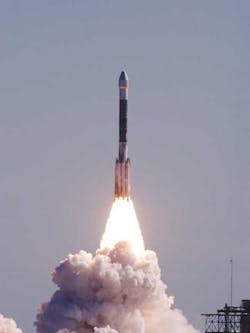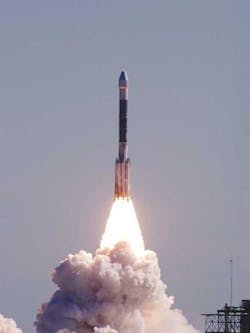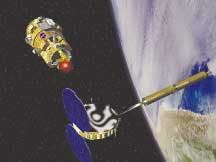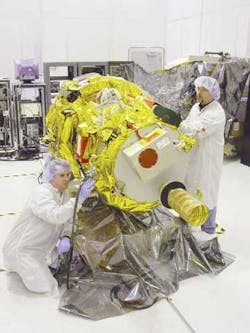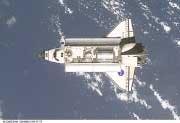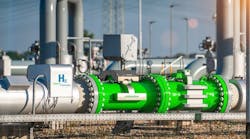NASA officials are working to meet President Bush’s goals for space exploration with initiatives such as Project Constellation, which includes a replacement for the Space Shuttle. Meanwhile, NASA has already begun testing autonomous technology for spacecraft.
By John McHale
President Bush spoke the words “the Moon, Mars, and beyond” a year ago when he outlined his lofty goals for the country’s space agency, NASA. Bush wants to see NASA not only return to the Moon, but have humans stroll through the Mars countryside as well as the surfaces of other worlds. NASA officials are calling it the “Vision for Space Exploration.” Under this new Vision, the first robotic missions will be sent to the Moon as early as 2008 and the first human missions as early as 2015 to test new approaches, systems, and operations for sustainable human and robotic missions to Mars and beyond.
Needless to say, this cannot be done overnight with today’s technology.
However, NASA and industry have already begun partnering and developing concepts and plans for next-generation spacecraft and the innovative electronics that will control them.
Crew Exploration Vehicle
One of the main goals under this strategy is to develop a new Crew Exploration Vehicle (CEV) to provide crew transportation for missions beyond low-Earth orbit and conduct the initial test flight before the end of this decade to provide an operational capability to support human exploration missions no later than 2014, NASA officials say.
The CEV program falls under Project Constellation, a planned architecture of human and robotic space exploration systems.
Officials at Northrop Grumman Corp. in El Segundo, Calif., and Boeing Integrated Defense Systems in St. Louis have already begun partnering to structure a team that will compete for NASA’s Crew Exploration Vehicle (CEV) and other elements of Project Constellation. The two companies were expected to finalize the teaming agreement last month.
CEV, the first of several space systems envisioned within Project Constellation, will serve as the architecture’s central human space transportation system.
“It is to bid impending contracts out of NASA’s exploration initiative,” said Doug Young, lead executive for Project Constellations at Northrop Grumman Integrated Systems during a press conference late last year. “The first major activity is the Crew Exploration Vehicle, which will make available an RFP (request for proposals) early [in 2005] with an award decision mid to the latter part of next year leading up to a selection of at least two teams going forward to 2008, when there will be a downselect to one, is the current NASA acquisition strategy.”
Under the agreement, Northrop Grumman will serve as the team’s leader and prime contractor during the initial development phase of the CEV, known as Spiral 1. During this period, which will demonstrate the CEV’s ability to operate safely with astronauts in low-Earth orbit, Boeing would serve as Northrop Grumman’s principal teammate and major subcontractor.
In subsequent Spirals of Project Constellation, NASA’s focus will expand from operating the CEV in low-Earth orbit to transporting astronauts to the Moon and beyond. In Spiral 2, the prime contractor leadership role will shift to Boeing for new human lunar CEV transportation system elements, with Northrop Grumman serving as Boeing’s principal teammate and major subcontractor. Northrop Grumman and Boeing will also determine the prime/subcontractor relationship for subsequent elements of Spiral 2 and 3 as NASA further defines Project Constellation.
Details about what type of launch vehicle should be used are still in the developmental stages and neither Boeing nor Northrop Grumman is ready to talk about it yet.
“We have been careful since we first started talking about exploration not to try to identify to NASA what we think the launch vehicle should be,” said Chuck Allen, vice president for Space Exploration Systems at Boeing during the same press conference. “We’ve tried to provide facts and data on different options and different capabilities that go from delta-type vehicles to shuttle-derived type vehicles to a clean-sheet design and heavy-lift vehicle. We have very carefully tried not to say what we think the answer ought to be, because that really does depend on the architecture and the requirements, which we don’t understand as well as NASA does to date, for sure.
“This alliance recognizes that the nation’s Vision for Space Exploration and the CEV system development will require as much innovation in program and business-management solutions as it requires in technology maturation and engineering.”
In the last year since the President made his announcement, the program has “achieved some significant strides in terms of getting an infrastructure put in place to manage the program,” Young said. “NASA has done positive things in terms of realigning the organization around those goals. We, in working with NASA on the early contracts are seeing a lot of the right steps being taken in terms of getting the requirements done right, which is for a program of this duration extremely important.
“The funding aspect of it is going to be critical, when we talk about a program that is sustainable and affordable, and that is part of one of the figures of merit that we are incorporating into our development of our trade studies and our system’s concept-to make sure that it is feasible within acknowledged funding pressures,” Young added.
Multiple players from industry will be involved as NASA moves forward with its Vision for Space Exploration.
“If you look at the Apollo program and other large, complex programs there are a number of different contractors that worked on various pieces,” Young said. “Grumman was the prime on the lunar module. Rockwell was the prime on the command and service modules. Others were the prime of other elements, so that is essentially how we will be continuing forward here. The CEV will be designed to incorporate the requirements of the follow-on missions that will be part of its duty.”
DART
Robotics will pave the way for future space exploration and NASA plans to begin demonstrating some of the promise autonomous technology offers with the DART - Demonstration of Autonomous Rendezvous Technology - scheduled for launch next month.
The new technology will enable a spacecraft to pinpoint and rendezvous with another craft without human guidance - a technology that is necessary if humans want to be able to deliver equipment and supplies to the International Space Station, conduct service missions to the station, retrieve satellites, or service civil, defense, or commercial space transportation space missions, NASA Marshall officials say.
Currently, only the Russian Progress and Soyuz spacecraft feature a completely automated docking system, NASA officials say. NASA’s Space Shuttles do have a docking targeting system, but it only assists the pilot in the maneuver.
The mission is “totally autonomous,” says Jim Snoddy, program manager for DART at Marshall Space Flight Center in Huntsville, Ala. Once it takes off no human control is possible, he adds.
DART recently completed successful ground tests, NASA officials say. The tests demonstrated the capability of DART hardware and software to communicate and to drive a spacecraft without human guidance, achieving a close approach to its target and a safe rendezvous.
Next comes a demonstration in space of the entire autonomous rendezvous system. DART’s launch is planned no earlier than March 2 from Vandenberg Air Force Base, Calif.
DART hardware and software technologies are integrated into Pegasus, a commercially developed space launch vehicle. The Pegasus, with the DART spacecraft aboard, will be launched from its Stargazer L-1011 aircraft about 40,000 feet over the Pacific Ocean. After Pegasus is released with the DART spacecraft, it will boost DART into a low-Earth polar orbit, where it will pass over each pole approximately every 99 minutes.
The DART spacecraft is about 6 feet long, with a diameter of 3 feet, and weighs approximately 800 pounds with fuel.
Once on orbit, DART will travel around Earth to rendezvous with its target - the Multiple Paths, Beyond-Line-of-Site Communications experimental communications satellite. The 105-pound target satellite, built by Orbital Sciences Corp. of Dulles, Va., and launched in 1999, was designed for use with a video guidance system such as the one onboard DART.
“I need many things to go right” for the launch to happen on March 2, Snoddy says. There is only a seven-minute window to make it happen, he adds.
DART technology
The vehicle combines two discrete systems into one: the DART spacecraft and the Pegasus launch vehicle, NASA officials say. The aft portion is the Pegasus fourth stage including the avionics assembly and Hydrazine Auxiliary Propulsion System (HAPS). The forward portion, referred to as the Advanced Video Guidance Sensor (AVGS) bus, houses a propulsion tank, Reaction Control System (RCS) thrusters, batteries, communications equipment, and the AVGS that will be used for navigational data during proximity operations.
The flight computer is from SBS Technologies in Albuquerque, N.M., Snoddy says. Radiation hardening of DART components was performed by NASA and Indiana University, Snoddy adds.
A global positioning system (GPS) that can receive signals from other spacecraft will enable DART to move within approximately 330 feet of the target. Once DART has reached that range, the spacecraft will use navigation data from its sensors to perform rendezvous maneuvers with the target. These sensors actually have a range of approximately 985 feet, overlapping with the GPS system.
This satellite was chosen because it was equipped with special optical reflectors for use in this type of situation, Snoddy says. Once DART has approached the satellite using the GPS system, the spacecraft will use its other sensors to demonstrate rendezvous operations, including approaching the target and moving around in close proximity to the satellite.
DART uses the AVGS to determine a spacecraft’s exact location, Snoddy says. It then feeds the information to its “brain,” the Automated Rendezvous and Proximity Operation (ARPO) software, which performs calculations and commands the spacecraft to turn, throttle, brake, and make decisions to rendezvous with another craft.
Orbital Sciences Corp. and NASA developed the AVGS, which actively uses laser and image technology to find and measure a known configuration of passive retroflectors on a target, and hence is a two-part system.
The AVGS utilizes geometric position of the return images from retroflectors to determine relative range, bearing, and attitude data when a valid target pattern is received. In the absence of a valid tracking target, the AVGS will return relative bearing information. The target geometric configuration contributes to the range performance characteristics of the system.
The AVGS will provide line of sight bearing from greater than one kilometer and provide 6-degrees-of-freedom (DOF) relative position and attitude data from 300 meters to dock.
ARPO
The main functions of the Automated ARPO system are guidance, navigation, control, and mission management. In the past, vehicles have been guided by humans in the loop with programs to assist in the accomplishment of specific tasks. Future development of transportation systems requires the ability to assemble spacecraft in Earth orbit, or around other celestial bodies, and the ability to dock, refuel, and transfer cargo between system elements.
The system’s foundation is a Honeywell Inertial Navigation System (INS) of rate gyros and accelerometers. Data has a tendency to drift in accuracy over time, so the use of a modified terrestrial Global Positioning System (GPS) for long-term stability and accuracy has been added to create a GPS/INS sensor.
A GPS system can only be used in low-Earth orbit (LEO), but other methods of navigational updates have been considered for use beyond LEO, NASA officials say. In LEO as many as 16 GPS satellites are available and can be used to increase the performance of the system.
The DART mission fuses AVGS sensors, the primary proximity sensor, with sensors in its internal navigation filter to give the best possible navigation state, during all mission phases, NASA officials say. This data is also used to create Keep Out Spheres around the target vehicle, which are used to determine and incorporate collision avoidance maneuvers to ensure safety.
The control system takes the guidance commands and performs the burns and consists of both a rotation and translation autopilot.
DART autonomy
The heart of the vehicle is the “mission manager,” or software that determines how the mission is performed. Mission manager determines the running mode of the guidance, navigation, and control system. It replaces the human or ground control used in the past, Snoddy says.
There are three levels of autonomy that this kind of system is capable of accomplishing. The first is a Scripted Mission Manager, which is linear and when problems arise the system will fail since it can only follow preprogrammed orders, NASA officials say.
The second level of autonomy, called Automated, allows for some level of replanning and contingency that has been preprogrammed by software designer.
The last level of autonomy is referred to as Autonomous Systems, which are complex with software that is difficult to verify because of its inherent non-linearity, NASA officials say.
DART is an autonomous system that has the ability to skip over events, change the order of operations, and replan the mission on the fly - precursor to a system that can think for itself, NASA officials say.
The technology gained in the DART program will be shared with the Orbital Express Program managed by the Defense Advanced Research Projects Agency
(DARPA). Orbital Express will validate the technical feasibility of robotic, autonomous on-orbit refueling, and reconfiguration of satellites.
Boeing Delta II sends NASA spacecraft on a rendezvous with a comet
A Boeing Delta II rocket recently launched a NASA spacecraft that will collide with a comet, causing a crater that will allow scientists to learn more about comets and their role in the formation of the universe.
The “Deep Impact” spacecraft was launched by a Delta II 7925-9.5 launch vehicle. Lift-off occurred from Space Launch Complex (SLC) 17B, Cape Canaveral Air Force Station, Fla.
The flight lasted approximately 34 minutes, placing Deep Impact into a trajectory path with the comet “Tempel 1.”
Deep Impact will release a projectile or “impactor” that will collide with Tempel 1 in July 2005. The impactor has an autonomous guidance system, propulsion system, and onboard cameras to keep it on course after its release from the mother ship, which will fly by Tempel 1 to take images of the comet after impact.
This mission “will reveal more information about how the universe was formed,” says Dan Collins, vice president, Boeing Expendable Launch Systems in St. Louis.
Deep Impact’s impactor measures 1-meter in diameter, 0.8-meters tall, and weighs approximately 370 kilograms. It will hit Tempel 1, leaving a crater somewhere between the size of a house and a football stadium, and approximately 2- to 14-stories deep. Post-impact debris, such as dust and gases, and the interior of the crater will also be observed by the Hubble, Spitzer, and Chandra telescopes as well as by telescopes on Earth. This is the first time that researchers will be able to study a comet’s interior.
The Delta II vehicle that launched Deep Impact used a Rocketdyne RS-27A main engine, nine Alliant Techsystems solid rocket boosters, an Aerojet AJ10-118K second-stage engine, a Thiokol Star 48B third-stage motor, and a nine-and-a-half-foot diameter payload fairing.
DART Quick Facts
Data provided by NASA Marshall Space Flight Center
DART Spacecraft
Length: 1.829 meters (6 feet)
Diameter: 0.92 meters (3 feet)
Weight: 363 kilograms (800 pounds)
Power: Six 50-amp-hour batteries with twp 9-amp-hour transient batteries
Batteries: Lithium ion
Pegasus XL Launch Vehicle
Manufacturer: Orbital Sciences Corp., Pegasus Stargazer L-1011 aircraft with Pegasus & Type launch vehicle
Length: 55 feet
Diameter: 4 feet
Wingspan: 22 feet
Weight: 51,000 lbs.
Stages: 4
Fuel: The Pegasus is an inertially guided three-stage solid rocket vehicle. The fourth stage includes an auxiliary propulsion system with three hydrazine fuel thrusters. The Pegasus reaction-control system includes six nitrogen-fueled thrusters producing 150 pounds of force.
Mission
Launch Date: March 2, 2005
Site: Vandenberg Air Force Base, Lompoc, Calif.
Duration: Approximately 24 hours
Orbit
Characteristics: Approximately 472 mile by 479 mile polar orbit, passing over each pole every 99.7 minutes
Semi-major axis: 7122.35 kilometers (4422.98 miles)
Eccentricity: 0.0004645
Apogee altitude: 659.1 kilometers (409.6 miles)
Perigee altitude: 639.5 kilometers (397.4 miles)
Inclination: 97.7548°
Argument of Perigee: 311.5608 degrees
Right Ascension of 354.8294 degrees ascending node
True Anomaly: 288.7
Cost
The approximate cost of the DART project, including launch is $95 million
Actel FPGAs support Mars Rover mission
Radiation-tolerant and radiation-hardened field-programmable gate arrays (FPGAs) from Actel Corp. in Mountain View, Calif., are performing critical functions in the Mars Exploration Rovers, Spirit and Opportunity, which have both surpassed the one-year mark of exploring the surface of Mars.
Actel FPGAs play roles in the camera electronics on each rover, among other functions.
A total of 28 Actel FPGAs have been used in the Mars Rover Mission. Some devices implement critical functions on the Rover Electronics Module and the Lander Electronics Module that are currently deployed on the surface of the planet, as well as on the Cruise Module that was part of the propulsion system to the planet, Actel officials say. Others implement the camera electronics on the rovers.
The space-optimized FPGAs deliver reliability at extreme temperatures and live at power-up functionality all on a single chip, which reduces component count, thereby minimizing power consumption and saving board space and weight, Actel officials say. Actel FPGAs are designed to have a high tolerance to the radiation and temperatures that the rovers have been exposed to in space and on the Martian surface, company officials say.
Actel FPGAs have also flown on Atlas II, Echostar, SBIRS-High, International Space Station, Mars Pathfinder, Mars Explorer Rovers 1 and 2, Mars Express Orbiter, Spirit and Opportunity Rovers, and the Hubble Space Telescope.
Actel Corporation is a supplier of programmable logic solutions, including field-programmable gate arrays (FPGAs) based on antifuse and flash technologies, intellectual property (IP) cores, software development tools, and design services, targeted for the high-speed communications, application-specific integrated circuit (ASIC) replacement, and radiation-tolerant markets. For more information go online at www.actel.com.
NASA selects Northrop Grumman proposals for technology for space exploration
NASA officials selected six Northrop Grumman Corp. proposals as 2004 came to a close to develop human and robotic technologies that would have roles in its Vision for Space Exploration.
The awards cover a variety of concepts to help NASA conduct sustainable and affordable exploration missions beyond low-Earth orbit. NASA’s Office of Exploration Systems Research and Technology (ESR&T) is funding the proposals. Work is expected to begin in early 2005.
Three examples of technologies the company will develop for the initiative include: an insect-like robot to autonomously inspect and maintain exteriors of spacecraft, such as the Space Shuttle, International Space Station, or the proposed Crew Exploration Vehicle; and a restowable, heat-resistant “skirt” that deploys around a spacecraft just before reentry; and an engine for a “space ferry” that would carry people and cargo between the Lunar surface and Lunar orbit as needed.
The six-legged robot would improve astronaut safety by reducing extravehicular activities. It is based upon an existing robot NASA’s Jet Propulsion Laboratory developed called Lemur, says Craig Allsop, director of space exploration systems at Northrop Grumman Space Technology in El Segundo, Calif. The robot will be used to inspect and repair autonomously in space.
Radiation hardening will need to be done and Northrop Grumman will select components to meet the requirements, Allsop says. Company engineers will also add grippers to the end of the legs, he adds.
By slowing the spacecraft significantly, the skirt reduces heat damage to the spacecraft, giving NASA a cost-effective option to re-use major elements of the spacecraft for future exploration missions.
The proposed engine would be refueled from materials mined on the moon, improving affordability by decreasing the use of one-time, expendable equipment. It is based upon a lunar module descent engine used for Apollo, Allsop says.
In addition to the three proposals above, Northrop Grumman will also pursue small, easily producible phased-array antennas for satellites using a low-cost electrically scanned array. This could reduce these antennas by 10 times in cost and size while providing extremely fast communications for space, ground and exploration vehicles, Northrop Grumman officials say.
The company will develop an “open systems,” health-management architecture that will demonstrate new ways to monitor and manage, on an integrated basis, the health, status, and resource availability of the major subsystems required to operate and maintain a space exploration system.
Last, Northrop Grumman engineers will produce a family of lightweight, self-cleaning, anticontamination coatings to address dust mitigation requirements for future moon and Mars missions.
“The maturation of these key technologies will help NASA reach its goal of implementing an integrated space exploration architecture that’s technically achievable, logistically supportable and economically sustainable well into the future,” says Doug Young, Northrop Grumman Integrated Systems’ director of space systems and corporate lead executive for Project Constellation.
